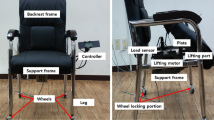Abstract
Sit-to-stand (STS) transfer is a basic and important motion function in daily living. Most currently-existing studies focus on movement assistance for patients who lost mobility or have impaired their muscle strength. In this article, a hip-active lower limb support exoskeleton is designed to assist load bearing STS transfer for healthy persons. In order to provide effective assistance, a self-designed quasi-direct drive actuator is adopted to compose the actuation module and a load bearing stand up assistance strategy is designed based on virtual modwhutel control and gravity compensation. Control parameters are optimized in a musculoskeletal simulation environment with kinematic and kinetic data obtained from the wearer. The experimental results show that muscle activation levels of gluteus maximus and semimembranous are reduced with the help from the proposed exoskeleton during load bearing STS transfer.
Access this chapter
Tax calculation will be finalised at checkout
Purchases are for personal use only
Similar content being viewed by others
References
Cao, W., et al.: A lower limb exoskeleton with rigid and soft structure for loaded walking assistance. IEEE Robotics and Automation Letters 7, 454–461 (2022)
Ma, L., Leng, Y., Jiang, W., Qian, Y., Fu, C.: Design an underactuated soft exoskeleton to sequentially provide knee extension and ankle plantarflexion assistance. IEEE Robotics and Automation Letters 7, 271–278 (2022)
Collins, S.H., Wiggin, M.B., Sawicki, G.S.: Reducing the energy cost of human walking using an unpowered exoskeleton. Nature 522, 212–215 (2015)
Witte, K.A., Fiers, P., Sheets-Singer, A.L., Collins, S.H.: Improving the energy economy of human running with powered and unpowered ankle exoskeleton assistance. Science Robotics 5, eaay9108 (2020)
Emmens, A.R., van Asseldonk, E.H.F., van der Kooij, H.: Effects of a powered ankle-foot orthosis on perturbed standing balance. J. Neuroeng. Rehabil. 15, 50 (2018)
Galli, M., Cimolin, V., Crivellini, M., Campanini, I.: Quantitative analysis of sit to stand movement: experimental set-up definition and application to healthy and hemiplegic adults. Gait Posture 28, 80–85 (2008)
Tsukahara, A., Kawanishi, R., Hasegawa, Y., Sankai, Y.: Sit-to-Stand and stand-to-sit transfer support for complete paraplegic patients with robot suit HAL. Adv. Robot. 24, 1615–1638 (2010)
Liu, X., Zhou, Z., Mai, J., Wang, Q.: Real-time mode recognition based assistive torque control of bionic knee exoskeleton for sit-to-stand and stand-to-sit transitions. Robot. Auton. Syst. 119, 209–220 (2019)
Mefoued, S., Mohammed, S., Amirat, Y., Fried, G.: Sit-to-Stand movement assistance using an actuated knee joint orthosis. In: 2012 4th IEEE RAS & EMBS International Conference on Biomedical Robotics and Biomechatronics (BioRob), pp. 1753–1758 (2012)
Song, Z., Tian, C., Dai, J.S.: Mechanism design and analysis of a proposed wheelchair-exoskeleton hybrid robot for assisting human movement. Mech. Sci. 10, 11–24 (2019)
Junius, K., Lefeber, N., Swinnen, E., Vanderborght, B., Lefeber, D.: Metabolic effects induced by a kinematically compatible hip exoskeleton during STS. IEEE Trans. Biomed. Eng. 65, 1399–1409 (2018)
Shepherd, M.K., Rouse, E.J.: Design and validation of a torque-controllable knee exoskeleton for sit-to-stand assistance. IEEE/ASME Trans. Mechatron. 22, 1695–1704 (2017)
Kamali, K., Akbari, A.A., Akbarzadeh, A.: Trajectory generation and control of a knee exoskeleton based on dynamic movement primitives for sit-to-stand assistance. Adv. Robot. 30, 846–860 (2016)
Huo, W., et al.: Impedance modulation control of a lower-limb exoskeleton to assist sit-to-stand movements. IEEE Transactions on Robotics, 1–20 (2021)
Wensing, P.M., Wang, A., Seok, S., Otten, D., Lang, J., Kim, S.: Proprioceptive actuator design in the MIT cheetah: impact mitigation and high-bandwidth physical interaction for dynamic legged robots. IEEE Trans. Rob. 33, 509–522 (2017)
Pratt, J., Chew, C.-M., Torres, A., Dilworth, P., Pratt, G.: Virtual model control: an intuitive approach for bipedal locomotion. The Int. J. Roboti. Res. 20, 129–143 (2001)
Delp, S.L., et al.: OpenSim: open-source software to create and analyze dynamic simulations of movement. IEEE Trans. Biomed. Eng. 54, 1940–1950 (2007)
Sun, J., Guo, Z., Zhang, Y., **ao, X., Tan, J.: A novel design of serial variable stiffness actuator based on an archimedean spiral relocation mechanism. IEEE/ASME Trans. Mechatron. 23, 2121–2131 (2018)
Acknowledgments
This work was supported by the National Natural Science Foundation of China under Grant 61603284 and 61903286.
Author information
Authors and Affiliations
Corresponding author
Editor information
Editors and Affiliations
Rights and permissions
Copyright information
© 2022 The Author(s), under exclusive license to Springer Nature Switzerland AG
About this paper
Cite this paper
Zhou, J., Zeng, Q., Tang, B., Luo, J., **ang, K., Pang, M. (2022). A Hip Active Lower Limb Support Exoskeleton for Load Bearing Sit-To-Stand Transfer. In: Liu, H., et al. Intelligent Robotics and Applications. ICIRA 2022. Lecture Notes in Computer Science(), vol 13456. Springer, Cham. https://doi.org/10.1007/978-3-031-13822-5_3
Download citation
DOI: https://doi.org/10.1007/978-3-031-13822-5_3
Published:
Publisher Name: Springer, Cham
Print ISBN: 978-3-031-13821-8
Online ISBN: 978-3-031-13822-5
eBook Packages: Computer ScienceComputer Science (R0)




